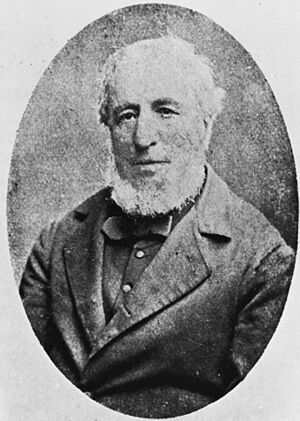Edward Davy facts for kids
Quick facts for kids
Edward Davy
|
|
|---|---|
 |
|
| Born | 16 June 1806 Ottery St Mary, Devon, England
|
| Died | 26 January 1885 (aged 78) Malmsbury, Victoria, Australia
|
| Nationality | British |
| Known for | Telegraphy |
| Scientific career | |
| Fields | Physics |
Edward Davy (16 June 1806 – 26 January 1885) was an amazing English scientist, doctor, and inventor. He was super important in creating the telegraph, which was like the internet of his time! He also invented something called an electric relay. This device helped send messages over very long distances.
Contents
Early Life and Education
Edward Davy was born on June 16, 1806, in a town called Ottery St Mary in England. His father was a doctor. Edward went to school in London, taught by his uncle. Later, he learned more about medicine by working with a doctor at a hospital.
He was a very smart student! In 1825, he won a special award for his knowledge of plants (botany). By 1829, he was fully qualified to be a doctor and a surgeon. After finishing his studies, Edward Davy started his own business. He worked as a chemist, making and selling chemical products. He even wrote a book called Experimental Guide to Chemistry in 1836.
Inventing the Telegraph
Edward Davy was very interested in new ways to communicate. In 1836, he wrote about a "New Plan of Telegraphic Communication." The next year, he started doing experiments to make his ideas work.
How Davy's Telegraph Worked
Davy showed off his telegraph in Regent's Park in London. He sent messages over a wire that was more than a mile long! This was a huge deal back then. In 1837, he showed a working model of his telegraph at a public event in Exeter Hall.
His invention was so good that it worried other inventors, like William Fothergill Cooke and Charles Wheatstone. They were also working on telegraphs and wanted to sell them to railway companies. Davy was talking to these same companies, which made Cooke and Wheatstone upset. They even tried to stop Davy, saying he was using their ideas.
The Electric Relay
Even with these challenges, Davy got a patent for his telegraph in 1838. A patent protects an invention, so others can't copy it. One of his most important inventions was the electric relay.
- The relay was a clever device.
- It used a magnetic needle.
- When electricity flowed, the needle moved.
- This movement made the needle touch a special mercury contact.
- This contact then completed another electric circuit.
This meant that a weak signal could be boosted to send a message even further. It was a key step in making long-distance telegraphy possible! Years later, in 1885, Davy was honored for this amazing invention. He became an honorary member of the Society of Telegraph Engineers.
Ideas for Wireless Communication
Edward Davy even thought about a type of "wireless" telegraphy. This was a very early idea, long before radio was invented! His idea was a mix of electrical and sound signals. He imagined a chain of sound transmitters, like bells, that would send a signal. At each stop, the sound would be picked up and then sent on again using his electric relay. It was a very advanced concept for his time, even if it wasn't fully developed.
Life in Australia
In 1838, Edward Davy moved to Australia. He stopped working on his telegraph inventions there. Years later, in 1847, a company called the Electric Telegraph Company bought his telegraph patents for £600. They mainly wanted the rights to his electric relay because it was so useful.
In Australia, Davy had many different jobs:
- He was an editor for a newspaper called the Adelaide Examiner.
- He became president of the Port Adelaide Mechanics' Institute.
- He worked for a smelting company, which processes metals.
- He was the chief assayer (someone who tests the purity of metals) for the government in Adelaide.
Later, he moved to Melbourne and continued his work as an assayer. After that, he tried farming for a short time. Finally, he settled in Malmsbury, Victoria, where he worked as a doctor for the rest of his life. He was even elected mayor of Malmsbury three times!

